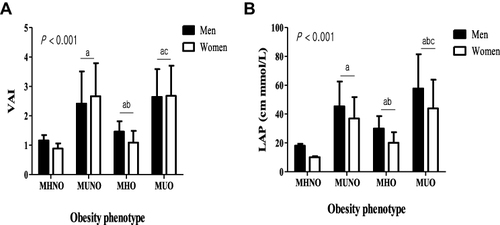Figures & data
Table 1 Anthropometric and Biochemical Measures According to Sex
Table 2 Anthropometric and Biochemical Measures According to Obesity Phenotype
Figure 1 Difference between VAI (A) and LAP (B) according to obesity phenotype.

Table 3 Areas Under the Receiver Operating Characteristic Curve (AUC) for Detecting Obesity Phenotype with VAI
Table 4 Areas Under the Receiver Operating Characteristic Curve (AUC) for Detecting Obesity Phenotype with LAP
Table 5 Odds Ratios (OR) and 95% Confidence Intervals (CI) for Obesity Phenotype Associated with VAI
Table 6 Odds Ratios (OR) and 95% Confidence Intervals (CI) for Obesity Phenotype Associated with LAP
